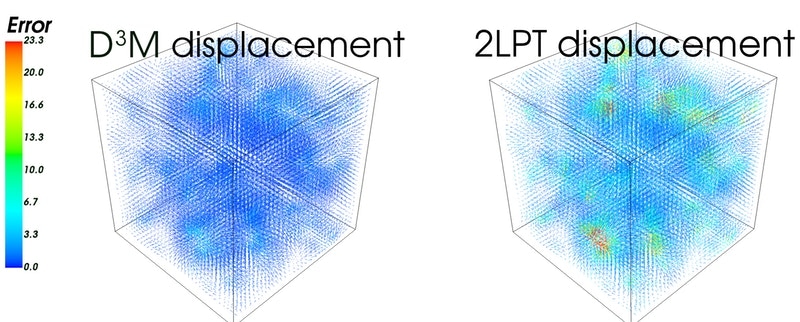Jun 27 2019
Using artificial intelligence techniques, astrophysicists have successfully created intricate 3D simulations of the universe for the first time. The outcomes are so robust, precise, and fast that even the creators are unsure how it all works.
 A comparison of the accuracy of two models of the universe. The new model (left), dubbed D3M, is both faster and more accurate than an existing method (right) called second-order perturbation theory, or 2LPT. The colors represent the average displacement error in millions of light-years for each point in the grid relative to a high-accuracy (though much slower) model. (Image credit: S. He et al./Proceedings of the National Academy of Sciences 2019)
A comparison of the accuracy of two models of the universe. The new model (left), dubbed D3M, is both faster and more accurate than an existing method (right) called second-order perturbation theory, or 2LPT. The colors represent the average displacement error in millions of light-years for each point in the grid relative to a high-accuracy (though much slower) model. (Image credit: S. He et al./Proceedings of the National Academy of Sciences 2019)
We can run these simulations in a few milliseconds, while other ‘fast’ simulations take a couple of minutes. Not only that, but we’re much more accurate.
Shirley Ho, Study Co-Author and Group Leader, Center for Computational Astrophysics, Flatiron Institute
The Center for Computational Astrophysics is located in New York City. Ho is also an adjunct professor at Carnegie Mellon University.
The precision and speed of the project, known as the Deep Density Displacement Model, or D3M for short, was not the biggest shock to the team. The real surprise was that D3M could precisely reproduce how the universe would appear upon tweaking certain parameters—for instance, how much of the cosmos constitutes dark matter—although the model did not get any kind of training data where those particular parameters differed.
“It’s like teaching image recognition software with lots of pictures of cats and dogs, but then it’s able to recognize elephants,” Ho explained. “Nobody knows how it does this, and it’s a great mystery to be solved.”
Along with colleagues, Ho presented D3M in the Proceedings of the National Academy of Sciences on June 24th. 2019. The study was headed by a Flatiron Institute research analyst, Siyu He.
Siyu he and Ho worked in association with Yin Li of the Berkeley Center for Cosmological Physics at the University of California, Berkeley, and the Kavli Institute for the Physics and Mathematics of the Universe near Tokyo; Wei Chen of the Flatiron Institute; Yu Feng of the Berkeley Center for Cosmological Physics; Barnabás Póczos of Carnegie Mellon University; and Siamak Ravanbakhsh of the University of British Columbia in Vancouver.
Such computer simulations made by the D3M model have become vital to theoretical astrophysics. Researchers prefer to know the way cosmos could emerge under different scenarios, for example, whether the dark energy pulling the universe apart differed over time.
For such studies, thousands of simulations have to be run, making an extremely accurate and lightning-fast computer model one of the main goals of modern astrophysics.
D3M models the way gravity molds the universe. The scientists opted to concentrate on only gravity because, to date, it is considered the most significant force when it comes to the evolution of the cosmos at large scale.
The most precise simulations of the universe estimate how gravity is able to shift each of the billions of separate particles over the whole age of the universe. It takes time to achieve that level of precision, needing about 300 computation hours for a single simulation. Although more rapid techniques can complete the same kinds of simulations in around two minutes, the shortcuts needed always lead to lower precision.
Siyu he, Ho, and their coworkers improved the deep neural network that drives the D3M model by feeding it 8,000 varied simulations from one among the highest accuracy models available.
By taking training data, neural networks run calculations on the information; the resulting outcome is then compared with the predicted outcome. With additional training, neural networks can adapt over time to produce more precise and faster results.
After training the D3M model, the team ran simulations of a box-shaped universe that was 600 million light-years across and eventually compared the outcomes to those of the fast and slow models. While the slow yet precise technique took hundreds of hours of computation time for each simulation and the existing fast model took two minutes, the D3M model can possibly complete the same simulation in just 30 milliseconds.
In addition to that, the D3M model also yielded precise results. It had a relative error of 2.8% when compared to the high-accuracy model. The existing fast model—using the same comparison—had a relative error of 9.3%.
Ho added that the incredible ability of the D3M model to manage parameter differences, which are not found in its training data, makes it a particularly flexible and useful tool.
Apart from modeling other types of forces, like hydrodynamics, Ho’s group is hoping to learn more about the workings of the model under the hood. By doing so, more benefits can be realized for the development of machine learning and artificial intelligence, stated Ho.
We can be an interesting playground for a machine learner to use to see why this model extrapolates so well, why it extrapolates to elephants instead of just recognizing cats and dogs. It’s a two-way street between science and deep learning.
Shirley Ho, Study Co-Author and Group Leader, Center for Computational Astrophysics, Flatiron Institute